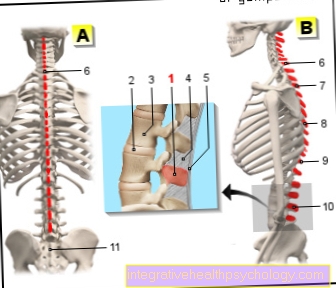Amoxicillin
definition
Amoxicillin is a prescription-only broad spectrum antibiotic (beta-lactam antibiotic) from the class of penicillins and is used to fight bacterial infections.

Areas of application
Amoxicillin is used in bacterial infections
- of Ear (Otitis media, also Otitis media)
- of the Paranasal, maxillary and frontal sinuses (Sinusitis)
- of the upper and lower airways (Pharyngitis, laryngitis, bronchitis).
- of the skin
- of Genitourinary tract (Cystitis, Urethritis)
- of the Gallbladder (Cholecystitis).
It will also be part of the Multitherapy against infections of the stomach Helicobacter pylori used. In addition to treating newly emerged bacterial infections, amoxicillin is also used to treat Prevention (prophylaxis) of bacterial infections used, for example to protect against Heart valve inflammation (Endocarditis) in patients to be operated on.
Also at Bite wounds For example, amoxicillin is used by dogs to prevent bacterial infections.
Amoxicillin does not work with all bacterial infections and especially not with viral infections, which is why it is particularly important not to take any tablets left on their own if you suspect an infection, but always to consult the responsible doctor beforehand!
Dosage and intake
Since amoxicillin is stable against gastric acid and can therefore pass through the stomach undamaged, it is usually taken orally as a tablet, but it can also be given as a juice or via an infusion.
The general dose is 250-500 mg every eight hours or 500-800 mg twice a day.
In addition, there are also retard tablets that release the active ingredient into the body over a longer period of time. With the amoxicillin prolonged-release tablet, it is sufficient to take one tablet (775 mg) a day.
In general, depending on the severity of the infection, amoxicillin can be taken in different doses over a different period of time; the exact dose setting is the responsibility of the attending physician. By combining it with preparations such as clavulanic acid, the spectrum of activity of amoxicillin can be expanded so that more bacteria can be attacked.
Before taking it, it is important to inform the attending physician about any amoxicillin or penicillin allergies and about any other medication taken at the same time, in order to avoid interactions and allergic reactions. In addition, if you have a known kidney disease, you should inform the attending physician, as amoxicillin is almost exclusively excreted via the kidneys. In the case of known phenylketonuria and medication with blood thinners, talk to the attending physician about alternatives or a specially adapted treatment plan.
When taking amoxicillin, it is important to take amoxicillin at the same times every day and to distribute the times of intake as far as possible over the day so that a constantly high level of the drug in the blood can be ensured. Only in this way can the bacterial infections be adequately combated. In addition, alcoholic beverages should be avoided during treatment with amoxicillin.
If a dose is missed, it should be taken immediately unless it is close to the next dose. In this case, the missed dose will not be taken and the normal medication plan will be returned to. Under no circumstances should two doses be taken at the same time if forgotten.
Read more on the topic: Amoxicillin dosage
Furthermore, it is important to have amoxicillin is taken for as long as prescribed by the attending physician has been. In particular, patients who feel they are no longer sick tend to stop taking the drug on their own and can relapse.
If you have problems taking tablets, the tablet can also be crushed and mixed with food or drink. Juice can also be given for patients with extensive swallowing difficulties.
While you are taking amoxicillin, it is important to tell other doctors, such as the dentist, that you are currently taking the drug. Furthermore, the attending physician must be informed about an existing pregnancy, current breastfeeding of an infant or an existing desire to have children in order to adequately advise the patient about the advantages and disadvantages of taking amoxicillin under these circumstances.
Amoxicillin in juice form
The juice form is mainly at Children very popular because taking tablets often causes problems here. The juice is also suitable for adults if it is not possible to swallow a tablet (e.g. after a stroke) or only succeeds with great difficulty. Amoxicillin is available either as a ready-made juice in various concentrations (5% / 10%) or as a powder that has yet to be made into a finished solution. In this case, the preparation must be carried out exactly according to the information on the package insert or the pharmacist in order to obtain the correct dosage. Usually there is a mark on the bottle to which the bottle must be filled with tap water. After filling, the bottle is shaken until no more powder residue can be seen in the bottle. Before each intake should the bottle be shaken again to ensure even distribution of the amoxicillin ingredient in the bottle. A measuring container for measuring quantities or a dosing syringe is usually included in the package.
The size of the pack is required by the family doctor based on body weight and other factors. Since different manufacturers use different additives, the juices in their Own taste distinguish. If the taste of a preparation is found to be unpleasant, a preparation from another manufacturer can simply be considered when re-prescribing. Especially with children, if it proves difficult to take with an unpleasant taste, a A change of preparation due to a different taste often makes it much easier to take.
Indicative strengths of amoxicillin
Amoxicillin 500
Amoxicillin 500 is suitable for treating acute or chronic infections in various parts of the body. The number 500 here describes the milligrams (mg) of active ingredient contained; here therefore 500mg of the antibiotic substance amoxicillin. Whether Amoxicillin 500 is sufficient depends on the person Severity of infection, the Age, Weight and the Kidney function of the person concerned. The required dose is calculated from these factors and taken in several individual doses divided over the day.
As with any antibiotic therapy, this is a prerequisite for the administration of amoxicillin Sensitivity of the pathogen to the antibiotic, because not every pathogen can be treated with every antibiotic. Amoxicillin 500 is frequently used for infections in the ear, nose and throat area and the respiratory tract. Above all there are one Otitis media (Otitis media), an inflammation of the sinuses (Sinusitis), tonsillitis (Tonsillitis), sore throat (Pharyngitis) or pneumonia (pneumonia). Amoxicillin 500 is also used for infections of the skin, soft tissues and bones.
Amoxicillin 750
Is Amoxicillin 500 re Potency not sufficient, amoxicillin 750 can be used. This now contains 750 milligrams instead of 500 milligrams per tablet. The indications are almost identical to those of Amoxicillin 500 and include the mentioned diseases of the ear, nose and throat area, respiratory tract, bones, soft tissues and skin as well as some very rare indications such as inflammation of the inner lining of the heart (Endocarditis).
Amoxicillin 1000
The areas of application of Amoxicillin 1000 are also similar to those of Amoxicillin 500 & 750. However, Amoxicillin 1000 has another sole area of application in the treatment of chronic Inflammation of the stomach lining through the germ Helicobacter pylori. If this is detected in a gastroscopy, a therapy scheme (consisting of three drugs) specially developed for this germ is applied. In this triple drug treatment Amoxicillin 1000 is an integral part of adults. Likewise, taking 3 x 1000mg amoxicillin for one day can be used as the sole therapy for a Urinary tract infection used in women. Amoxicillin can also be safely used during pregnancy.
Side effects of amoxicillin
All drugs can cause side effects. In general, however, no side effects are observed when treating with amoxicillin. Even so, it can occasionally be too Stomach rumbling, stomach pain or to Vomit come. It is recommended that lots of small meals to eat, one good oral hygiene operate as well sugar-free chewing gum to chew. If the symptoms occur particularly when taking the tablet, the tablet can be mixed with food.
In addition to vomiting, it can also be too diarrhea (Diarrhea) come. This can be done through the Consumption of yogurt or other probiotic foods be contained.
In women it can become one Fungal infection of the vagina come, which should be reported to the attending doctor or gynecologist if itching or discharge occurs.
In addition to the side effects already listed, there may also be side effects that require immediate contact to the treating doctor. An unknown allergy to amoxicillin or penicillins in general can lead to a allergic reaction come across amoxicillin. In the event of an allergic reaction, a doctor should be consulted immediately. Skin rashes, Swelling, Redness and itching occur. In addition, in a few cases it can also severe shortness of breath and fever come that through a anaphylactic shock can also be fatal and must therefore be treated immediately in the emergency room.
itching is one of the common side effects of amoxicillin. When it comes to medication, often means that up to 10 out of 100 people will experience the side effects. Often times the itch is from one skin rash accompanied, which is noticeable in the form of red spots or pustules. The itching is not like from other symptoms Shortness of breathwhat can be an indication of an allergy accompanies it mostly harmless and subsides on its own after the end of therapy. Even if it is not dangerous, the itching during this time can be very painful. So-called Antihistamines create. Most people are already familiar with these preparations against hay fever and they can be found in the medicine cabinet. Well-known representatives are here Loratadine or Cetirizine. If none are available, they can be obtained from the pharmacy without a prescription. Even if the itching under the medication with the Antihistamines disappears, it is recommended to see your family doctor to report the side effect.
Read more about the topic here: Itching when taking amoxocillin
If the vomiting or diarrhea is particularly severe or persists after stopping amoxicillin, it is advisable to consult a doctor here as well.
At newly emerged bruises (Hematomas) such as Bleeding with no apparent external cause a doctor should also be consulted immediately. In addition to the side effects already mentioned, a doctor should be consulted immediately if the following symptoms occur: Mental changes, insomnia, confusion, Anxiety, increased sensitivity to light and noise and Clouding of consciousness.
As a rule, penicillins are non-toxic to humans and can therefore normally be taken during pregnancy.
When prescribing amoxicillin, it is important to inform the attending physician about all current medications. The following drug groups can cause side effects: blood thinner (Anticoagulants), Allopurinol (used to treat gout), pill, other antibiotics, Chemotherapy drugs used to treat cancer (Methotrexate) as well as the Typhoid vaccination.
Please also read our article on this Antibiotic side effects
Amoxicillin and milk
Amoxicillin is an antibiotic that is chemically very similar to penicillin. Some drugs are said to be used do not take with milk should. The reason for this is that milk is a fat-loving (lipophilic) substance acts which while you are about the Intestines is included that Block channels through which lipophilic drugs would be absorbed.
In the case of amoxicillin, however, it is absorbed through the intestines by drinking milk not disabled becomes. The taking of Amoxicillin with milk is so easily possible, without the antibiotic becoming less effective. Antibiotics like the Tetrazykline should not combined with milk or even be taken with it. Milk and amoxicillin, however, get along very well and there is no risk of increased or decreased effects of amoxicillin.
Please also read: Amoxicillin and Milk Interactions
Amoxicillin and alcohol
Amoxicillin is a antibiotic, which has a similar chemical structure to the Penicillins having. Amoxicillin is mainly excreted through the kidneys.
Alcohol or its chemical component, ethanol, is mainly produced via the liver metabolized. Taking the two substances together does not pose a risk for the time being. However, taking amoxicillin is linked to a bacterial infection, the presence of which has already weakened the body.
Alcohol is always an additional stress factor for the body and should be left out for the sake of recovery when taking amoxicillin. With others Antibiotics However, there may be interactions with alcohol. If you are taking an antibiotic, please read the package insert beforehand or ask your doctor or pharmacist.
A lot of extensive information and the extent to which alcohol and amoxicillin are still possible can be found under our topic: Amoxicillin and alcohol
Amoxicillin and sun exposure
Many antibiotics cause the so-called Photosensitization of the body, which means the skin much more sensitive and sensitive reacts to sunlight. For example, this makes it easier for you to get sunburned. In extreme cases, the skin can also be burned even though it has not been exposed to extreme sunlight. Amoxicillin is one of the various active ingredients in the field of antibiotics the group of so-called penicillinswhich partly bring this side effect with it.
For amoxicillin, the side effect is the Photosensitization but not specifically described as it occurs very rarely and is therefore very unlikely. So it applies in principle no "sun ban"However, it does not harm people who are very light-sensitive in everyday life to avoid spending time in the sun while taking amoxicillin in order to keep the risk as low as possible.
Allergy to amoxicillin
Amoxicillin is an antibiotic that belongs to the Broad spectrum antibiotics because amoxicillin is effective against a wide range of bacteria. Amoxicillin belongs to the group of Penicillin antibioticsAs with other drugs alone, amoxicillin can cause a allergic reaction due to an allergy to amoxicillin. This allergy to amoxicillin can manifest itself in very different ways.
Many patients with an allergy to amoxicillin complain about taking it Itching of the skin or it is formed Red stain and or Rashes. However, it can too nausea with or without Vomit or to shortness of breath (Dyspnea) come. The symptoms of an allergy to amoxicillin can therefore be very different and are individually dependent on the patient. It is often difficult to distinguish which symptoms are caused by an allergy and which symptoms are side effects of the antibiotic. Patients with a Penicillin hypersensitivity or one Penicillin allergy should refrain from taking amoxicillin because of its chemical relationship with one similar allergic reaction is to be expected. In the worst case it can be up to a so-called anaphylactic shock come which one through itch (Pruritus) of the skin, severe shortness of breath (Dyspnea) and Tachycardia can be marked. It is important to look at the first signs of an allergy Ingestion of amoxicillin cancel and one To see a doctor. A increased likelihood Patients who get an allergic reaction to amoxicillin have immune system anyway weakened is.
Read a lot more information on this topic at: Amoxicillin allergy
Amoxicillin rash
Amoxicillin is a Broad spectrum antibiotic, which is very popular on the one hand because it can be used against a large number of bacteria, on the other hand, the broad effect ensures that it multiplies Side effects can come. A common side effect of taking amoxicillin is a Rash on the skin. This rash, triggered by taking amoxicillin, can look very different and can also take on very different dimensions. From a harmless, small skin rash to large, allergic skin rashes, the rash caused by amoxicillin can take on very different dimensions, depending on the patient. The rash can be with itching accompanied. In other patients, amoxicillin may increase allergic reactions come, which can be accompanied by a rash and often also with so-called Wheals expresses.
If there is such a thing severe rash while taking amoxicillin, one should urgently Consulted a doctor be and the Ingestion of amoxicillin should interrupted become. If, on the other hand, there is only a slight reddening with a slight itching, the doctor should be asked whether amoxicillin can be continued or whether the intake should be interrupted.
Read a lot more information on our site: Amoxicillin rash
Amoxicillin in children
Also at Children the antibiotic amoxicillin is used for some infectious diseases, as it is also used for children in general very well tolerated is. The dosage with children depends on the one hand Age and on the other hand after body weight. Accordingly, children receive a body weight up to 40 kilograms about one Daily dose of amoxicillin of a maximum of 2000 milligrams. The daily dose is divided into three to four individual doses of 50-100mg each. Children with a body weight over 40 milligrams receive one similar to adults Daily dose up to 3000 mg. The administration of antibiotics in children is carried out according to an accurate calculation. Since children often do not like to take pills, amoxicillin is also available as a juice or suspension. It also poses in children no problem dar, the antibiotic with milk or Dairy products to be taken, as amoxicillin does not interact with the minerals contained in milk. The effectiveness is not lost.
Amoxicillin in pregnancy

The Antibiotic amoxicillin should, as long as the doctor has not prescribed otherwise, in the pregnancy not be taken. So far there is no conclusive studies to the fact that the ingestion has a negative effect on the unborn child and it can cause damage. Nevertheless, they occurred more frequently in individual studies Intestinal inflammation of the child after giving birth due to taking the antibiotic. As a precaution administration should therefore be avoided.
Read more about the topic here: Antibiotics in Pregnancy
Amoxicillin while breastfeeding
The Antibiotic should also should not be used during breastfeedingunless the attending physician sees no other option to switch to another antibiotic. Amoxicillin will through breast milk into the child's body and can also be transferred to a Damage to the healthy intestinal flora to lead. It can also cause complaints like stomach pain and diarrhea come. If amoxicillin has to be taken, the mother can stop breastfeeding beforehand and thus protect the child.
Interaction with the contraceptive pill
The taking of Antibiotics and the classic contraceptives most women can too problematic become. The Antibiotic can make the pill less effectiveThat is why it should be borne in mind while taking amoxicillin reduced contraceptive protection consists.





























